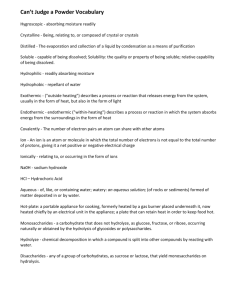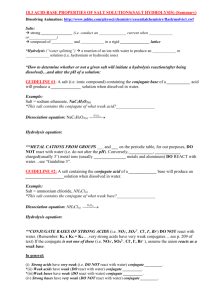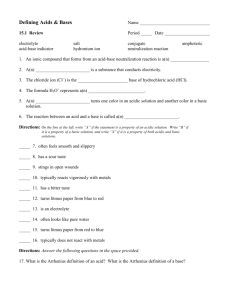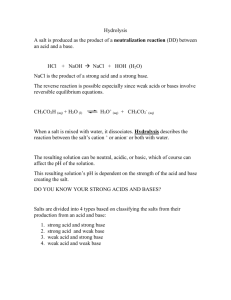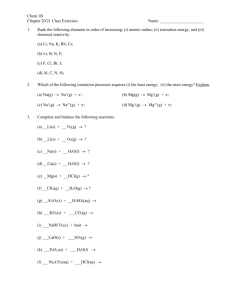Sec 4.13 - teacher notes
advertisement
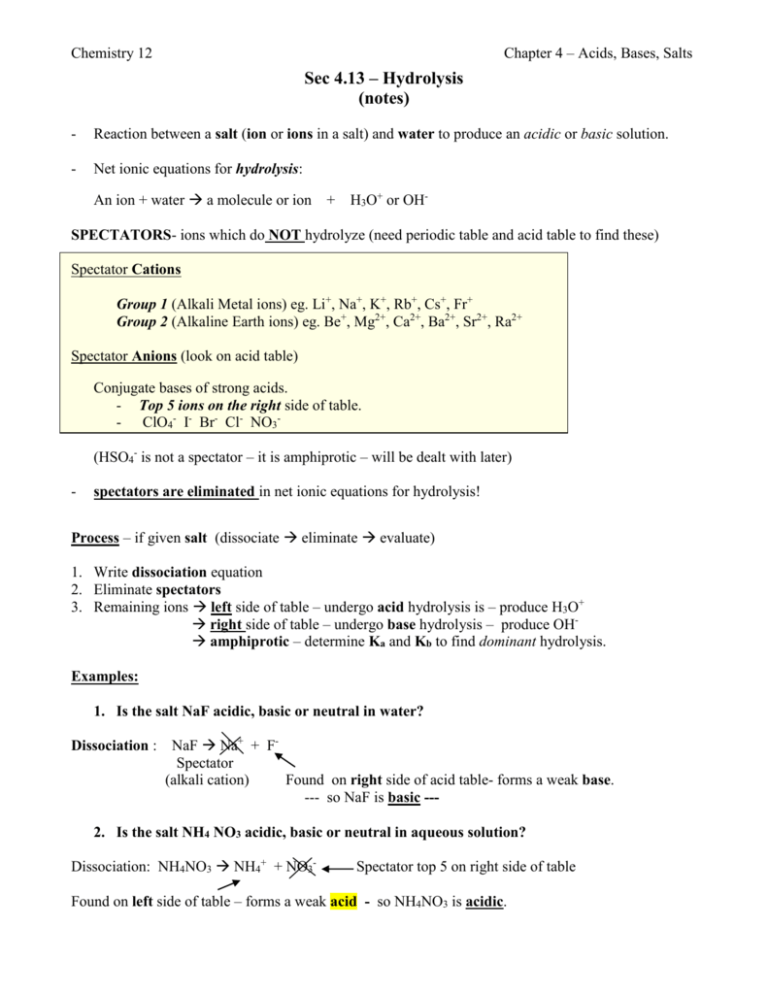
Chapter 4 – Acids, Bases, Salts Chemistry 12 Sec 4.13 – Hydrolysis (notes) - Reaction between a salt (ion or ions in a salt) and water to produce an acidic or basic solution. - Net ionic equations for hydrolysis: An ion + water a molecule or ion + H3O+ or OH- SPECTATORS- ions which do NOT hydrolyze (need periodic table and acid table to find these) Spectator Cations Group 1 (Alkali Metal ions) eg. Li+, Na+, K+, Rb+, Cs+, Fr+ Group 2 (Alkaline Earth ions) eg. Be+, Mg2+, Ca2+, Ba2+, Sr2+, Ra2+ Spectator Anions (look on acid table) Conjugate bases of strong acids. - Top 5 ions on the right side of table. - ClO4- I- Br- Cl- NO3(HSO4- is not a spectator – it is amphiprotic – will be dealt with later) - spectators are eliminated in net ionic equations for hydrolysis! Process – if given salt (dissociate eliminate evaluate) 1. Write dissociation equation 2. Eliminate spectators 3. Remaining ions left side of table – undergo acid hydrolysis is – produce H3O+ right side of table – undergo base hydrolysis – produce OH amphiprotic – determine Ka and Kb to find dominant hydrolysis. Examples: 1. Is the salt NaF acidic, basic or neutral in water? Dissociation : NaF Na+ + FSpectator (alkali cation) Found on right side of acid table- forms a weak base. --- so NaF is basic --- 2. Is the salt NH4 NO3 acidic, basic or neutral in aqueous solution? Dissociation: NH4NO3 NH4+ + NO3- Spectator top 5 on right side of table Found on left side of table – forms a weak acid - so NH4NO3 is acidic. Chapter 4 – Acids, Bases, Salts Chemistry 12 3. Is the salt KCl acidic, basic or neutral? Dissociation: KCl K+ + Cl- --- since neither ion undergoes hydrolysis, this salt is NEUTRAL. 4. Cations Which Hydrolyze - Hydrated cations i. metals from center of the periodic table (transition metals) are smaller ions and have larger charges - this attracts H2O molecules eg.) Fe3+ Hydration: Fe3+ + 6H2O Fe(H2O)63+ This ion acts as a weak acid (see it ~ 13th down on the acid table.) The equation for the hydrolysis is: Fe(H2O)63+(aq) + H2O(l) H3O+(aq) + Fe(H2O)5(OH) 2+ (aq) 3 Common Hydrated cations (on left of acid chart): iron(III) Fe3+ forms Fe(H2O)63+ Chromium(III) Cr3+ forms Cr(H2O)63+ Aluminum Al3+ forms Al(H2O)63+ Act as weak acids. Eg.) AlCl3 is the same as Al(H2O)6Cl3 NH4+ Hydrolysis equation: NH4+(aq) + H2O(l) H3O+(aq) + NH3(aq) 5. Anions which Hydrolyze Looking on the RIGHT side of the ACID TABLE: Remember the TOP 5 DO NOT hydrolyze – they are spectators HSO4- is amphiprotic From IO3- to PO43- under go base hydrolysis The BOTTOM 3 - act as STRONG BASES. They undergo 100% hydrolysis to form OH- ions Some examples of net-ionic hydrolysis equations for these would be: IO3- (aq) + H2O (l) CH3COO- (aq) + H2O (l) HIO3 (aq) + OH- (aq) CH3COOH (aq) + OH- (aq) Chapter 4 – Acids, Bases, Salts Chemistry 12 Eg.) Determine whether the salt sodium carbonate (Na2CO3) is acidic, basic or neutral in aqueous solution. First dissociate the salt: Na2CO3 _______________________________ The net-ionic equation for the hydrolysis taking place in this salt would be: CO32- (aq) + H2O (l) _________________ and the salt would act as a weak base in water. Remember that “net-ionic” means that any spectator ions have been removed! Write the net-ionic equation for the hydrolysis taking place in aqueous magnesium sulphate: 6. Hydrolysis When BOTH Cation and Anion hydrolyze Eg. Is the salt ammonium nitrite NH4NO2 acidic, basic or neutral? Of course we start out by dissociating: NH4NO2 Remember that NH4+ produces H3O+ (NH4+ + H2O And NO2- produces OH- (NO2- + H2O ) (equation 1) ) (equation 2) The Ka for NH4+ tells how much H3O+ it produces The Kb for NO2- tells how much OH- it produces The Ka for NH4+ is 5.6 x 10-10 (look up NH4+ on the left side of the table and it’s Ka is on the right) The Kb for NO2- must be calculated: Kb (NO2) = Since the Ka of NH4+ > Kb of NO2- Kw = 1.0 x 10-14 = 2.2 x 10-11 Ka (HNO2) 4.6 x 10-4 - We can say that this salt is ACIDIC So, in summary: If Ka (cation) > Kb (anion) Kb (anion) > Ka (cation) Ka (cation) = Kb (anion) Then the salt is: Acidic Basic Neutral Determine whether the salt NH4CN (ammonium cyanide) is acidic, basic or neutral. NH4CN NH4+(aq) + CN-(aq) Ka of NH4+ = 5.6 x 10-10 1.0 x10 14 2.0 x10 5 Kb of CN- = 4.9 x10 10 so since Kb of CN- > Ka of NH4+ this solution is basic. Chapter 4 – Acids, Bases, Salts Chemistry 12 7. Hydrolysis of Amphiprotic Anions Amphiprotic Anions Start with “H” and have a “-“ charge. Eg. HSO4- , HSO3- , H2PO4- HPO42- HS- etc. Amphiprotic Anions hydrolyze as acids to produce H3O+ but they also hydrolyze as bases to produce OH- So, how can we tell whether they are acidic or basic or neutral? We need to determine the predominant hydrolysis Find the Ka of the ion. (Look for ion on the LEFT SIDE of the acid table, read Ka on the right.) Find the Kb of the ion. (Look for the ion on the RIGHT SIDE of the table and use: Kb = Kw/ Ka(conj. Acid) If Then the predominant hydrolysis is: And, in aqueous solution, the ion: Ka (the ion) > Kb (the ion) Kb (the ion) > Ka (the ion) ACID HYDROLYSIS Acts as an Acid BASE HYDROLYSIS Acts as a Base Eg. Find the predominant hydrolysis of the hydrogen carbonate ion (HCO3-) and write the net-ionic equation for it. To find the Ka of HCO3-, look it up on the left side of table. It’s Ka = 5.6 x 10-11 To find the Kb of HCO3-, look it up of the right side of table. ( It’s conjugate acid is H2CO3 and the Ka of H2CO3 = 4.3 x 10-7 ) So we calculate the Kb of HCO3- using : Kb(HCO3-) = Kw = Ka(H2CO3) 1.0 x 10-14 = 2.3 x 10-8 4.3 x 10-7 So, since Kb > Ka , the ion HCO3- predominantly undergoes BASE HYDROLYSIS. And the net-ionic equation for the predominant hydrolysis is: HCO3-(aq) + H2O(l) H2CO3 (aq) + OH- (aq) Read p. 144 – 147 in SW & Do Ex. 69 (a-f) and Ex. 70 (a – j), 71, 72 & 73 on p. 148. Chapter 4 – Acids, Bases, Salts Chemistry 12 Sec 4.13 – Hydrolysis (student notes) - Net ionic equations for hydrolysis: SPECTATORS- (need periodic table and acid table to find these) Spectator Cations Group 1 (Alkali Metal ions) eg. Li+, Na+, K+, Rb+, Cs+, Fr+ Group 2 (Alkaline Earth ions) eg. Be+, Mg2+, Ca2+, Ba2+, Sr2+, Ra2+ Spectator Anions (look on acid table) - Conjugate bases of strong acids. Top 5 ions on the right side of table. ClO4- I- Br- Cl- NO3- (HSO4- is not a spectator – it is amphiprotic – will be dealt with later) - _________________________ in net ionic equations for hydrolysis! Process – if given salt (____________________________ ______________) 1. Write dissociation equation 2. Eliminate spectators 3. Remaining ions left side of table – undergo acid hydrolysis is – produce H3O+ right side of table – undergo base hydrolysis – produce OH amphiprotic – determine Ka and Kb to find dominant hydrolysis. Examples: 1. Is the salt NaF acidic, basic or neutral in water? Dissociation : NaF Na+ + FFound on right side of acid table- forms a weak base. --- so NaF is _________ --- 2. Is the salt NH4 NO3 acidic, basic or neutral in aqueous solution? Dissociation: NH4NO3 NH4+ + NO3Found on left side of table – forms a _____________ - so NH4NO3 is __________ . Chapter 4 – Acids, Bases, Salts Chemistry 12 3. Is the salt KCl acidic, basic or neutral? Dissociation: KCl K+ + Cl- --- since neither ion undergoes hydrolysis, this salt is ___________. 4. Cations Which Hydrolyze - Hydrated cations - metals from center of the periodic table (transition metals) are smaller ions and have larger charges - this attracts H2O molecules eg.) Fe3+ Hydration: Fe3+ + 6H2O Fe(H2O)63+ This ion acts as a weak acid (see it ~ 13th down on the acid table.) The equation for the hydrolysis is: Fe(H2O)63+(aq) + H2O(l) H3O+(aq) + Fe(H2O)5(OH) 2+ (aq) 3 Common Hydrated cations (on left of acid chart): Iron(III) Fe3+ Chromium(III) Cr3+ Aluminum Al3+ forms Fe(H2O)63+ forms Cr(H2O)63+ forms Al(H2O)63+ Act as weak acids. Eg.) AlCl3 is the same as Al(H2O)6Cl3 NH4+ Hydrolysis equation: NH4+(aq) + H2O(l) H3O+(aq) + NH3(aq) 5. Anions which Hydrolyze Looking on the RIGHT side of the ACID TABLE: Remember the TOP 5 DO NOT hydrolyze – they are spectators HSO4- is amphiprotic From IO3- to PO43- under go base hydrolysis The BOTTOM 3 - act as STRONG BASES. They undergo 100% hydrolysis to form OH- ions Some examples of net-ionic hydrolysis equations for these would be: IO3- (aq) + H2O (l) CH3COO- (aq) + H2O (l) _________________________ _____________________________ Chapter 4 – Acids, Bases, Salts Chemistry 12 Eg.) Determine whether the salt sodium carbonate (Na2CO3) is acidic, basic or neutral in aqueous solution. First dissociate the salt: Na2CO3 ______________________________ The net-ionic equation for the hydrolysis-taking place in this salt would be: CO32- (aq) + H2O (l) _________________ and the salt would act as a weak base in water. Remember that “net-ionic” means that any spectator ions have been removed! Write the net-ionic equation for the hydrolysis taking place in aqueous magnesium sulphate: 6. Hydrolysis When BOTH Cation and Anion hydrolyze Is the salt ammonium nitrite NH4NO2 acidic, basic or neutral? Start out by dissociating: NH4NO2 ______________________________ Remember that NH4+ produces H3O+ (NH4+ + H2O And NO2- produces OH- (NO2- + H2O H3O+ + NH3) (equation 1) HNO2 + OH- ) (equation 2) The Ka for NH4+ tells how much H3O+ it produces The Kb for NO2- tells how much OH- it produces The Ka for NH4+ is ____________(look up NH4+ on the left side of the table and it’s Ka is on the right) The Kb for NO2- must be calculated: Kb (NO2) = Since the Ka of NH4+ > Kb of NO2- Kw = Ka (HNO2) - We can say that this salt is _________________ So, in summary: If Ka (cation) > Kb (anion) Kb (anion) > Ka (cation) Ka (cation) = Kb (anion) Then the salt is: Acidic Basic Neutral Determine whether the salt NH4CN (ammonium cyanide) is acidic, basic or neutral. Chapter 4 – Acids, Bases, Salts Chemistry 12 7. Hydrolysis of Amphiprotic Anions Amphiprotic Anions Start with “H” and have a “-“ charge. Ex. HSO4- , HSO3- , H2PO4- HPO42- HS- etc. Amphiprotic Anions hydrolyze as acids to produce H3O+ but they also hydrolyze as bases to produce OH- So, how can we tell whether they are acidic or basic or neutral? We need to determine the predominant hydrolysis Find the Ka of the ion. (Look for ion on the LEFT SIDE of the acid table, read Ka on the right.) Find the Kb of the ion. (Look for the ion on the RIGHT SIDE of the table and use: Kb = Kw/ Ka(conj. acid) If Then the predominant hydrolysis is: And, in aqueous solution, the ion: Ka (the ion) > Kb (the ion) Kb (the ion) > Ka (the ion) ACID HYDROLYSIS Acts as an Acid BASE HYDROLYSIS Acts as a Base Ex. Find the predominant hydrolysis of the hydrogen carbonate ion (HCO3-) and write the net-ionic equation for it. Read p. 144 – 147 in SW & Do Ex. 69 (a-f) and Ex. 70, 71, 72 & 73 on p. 148. Chapter 4 – Acids, Bases, Salts Chemistry 12 Sec 4.13 – Hydrolysis - Reaction between a salt (ion or ions in a salt) and water to produce an acidic or basic solution. - Net ionic equations for hydrolysis: An ion + water a molecule or ion + H3O+ or OH- SPECTATORS- ions which do NOT hydrolyze (need periodic table and acid table to find these) Spectator Cations Group 1 (Alkali Metal ions) eg. Li+, Na+, K+, Rb+, Cs+, Fr+ Group 2 (Alkaline Earth ions) eg. Be+, Mg2+, Ca2+, Ba2+, Sr2+, Ra2+ Spectator Anions (look on acid table) Conjugate bases of strong acids. - Top 5 ions on the right side of table. - ClO4- I- Br- Cl- NO3(HSO4- is not a spectator – it is amphiprotic – will be dealt with later) - spectators are eliminated in net ionic equations for hydrolysis! Process – if given salt (dissociate eliminate evaluate) 1. Write dissociation equation 2. Eliminate spectators 3. Remaining ions left side of table – undergo acid hydrolysis is – produce H3O+ right side of table – undergo base hydrolysis – produce OH amphiprotic – determine Ka and Kb to find dominant hydrolysis. Chapter 4 – Acids, Bases, Salts Chemistry 12 Examples: 1. Is the salt NaF acidic, basic or neutral in water? NaF Na+ + FSpectator (alkali cation) Found on right side of acid table- forms a weak base. --- so NaF is basic --- Dissociation : 2. Is the salt NH4 NO3 acidic, basic or neutral in aqueous solution? Dissociation: NH4NO3 NH4+ + NO3Spectator top 5 on right side of table Found on left side of table – forms a weak acid - so NH4NO3 is acidic. 3. Is the salt KCl acidic, basic or neutral? Dissociation: KCl K+ + Cl- --- since neither ion undergoes hydrolysis, this salt is NEUTRAL. 4. Cations Which Hydrolyze - Hydrated cations metals from center of the periodic table (transition metals) are smaller ions and have larger charges - this attracts H2O molecules eg.) Fe3+ Hydration: Fe3+ + 6H2O Fe(H2O)63+ This ion acts as a weak acid (see it ~ 13th down on the acid table.) The equation for the hydrolysis is: Fe(H2O)63+(aq) + H2O(l) H3O+(aq) + Fe(H2O)5(OH) 2+ (aq) Chapter 4 – Acids, Bases, Salts Chemistry 12 3 Common Hydrated cations (on left of acid chart): Iron(III) Fe3+ forms Fe(H2O)63+ Chromium(III) Cr3+ forms Cr(H2O)63+ Aluminum Al3+ forms Al(H2O)63+ Act as weak acids. Eg.) AlCl3 is the same as Al(H2O)6Cl3 NH4+ Hydrolysis equation: NH4+(aq) + H2O(l) H3O+(aq) + NH3(aq) 5. Anions which Hydrolyze Looking on the RIGHT side of the ACID TABLE: Remember the TOP 5 DO NOT hydrolyze – they are spectators HSO4- is amphiprotic From IO3- to PO43- under go base hydrolysis The BOTTOM 3 - act as STRONG BASES. They undergo 100% hydrolysis to form OH- ions Some examples of net-ionic hydrolysis equations for these would be: IO3- (aq) + H2O (l) CH3COO- (aq) + H2O (l) HIO3 (aq) + OH- (aq) CH3COOH (aq) + OH- (aq) Eg.) Determine whether the salt sodium carbonate (Na2CO3) is acidic, basic or neutral in aqueous solution. First dissociate the salt: Na2CO3 2 Na+(aq) + CO32-(aq) The net-ionic equation for the hydrolysis taking place in this salt would be: CO32- (aq) + H2O (l) HCO-3 (aq) + OH- (aq) and the salt would act as a weak base in water. Remember that “net-ionic” means that any spectator ions have been removed! Chapter 4 – Acids, Bases, Salts Chemistry 12 Write the net-ionic equation for the hydrolysis taking place in aqueous magnesium sulphate: MgSO4 (aq) ⇆ Mg+2 + SO4-2 SO42-(aq) + H2O(l) ⇆ HSO4-(aq) + OH-(aq) 6. Hydrolysis When BOTH Cation and Anion hydrolyze Ex. Is the salt ammonium nitrite NH4NO2 acidic, basic or neutral? Of course we start out by dissociating: NH4NO2 NH4+(aq) + NO2-(aq) Remember that NH4+ produces H3O+ (NH4+ + H2O H3O+ + NH3) And NO2- produces OH- (NO2- + H2O HNO2 + OH- ) The Ka for NH4+ tells how much H3O+ it produces The Kb for NO2- tells how much OH- it produces The Ka for NH4+ is 5.6 x 10-10 (look up NH4+ on the left side of the table and it’s Ka is on the right) The Kb for NO2- must be calculated: Kb (NO2) = Since the Ka of NH4+ > Kb of NO2So, in summary: Kw = 1.0 x 10-14 Ka (HNO2) 4.6 x 10-4 = 2.2 x 10-11 - We can say that this salt is ACIDIC If Ka (cation) > Kb (anion) Kb (anion) > Ka (cation) Ka (cation) = Kb (anion) Then the salt is: Acidic Basic Neutral Chapter 4 – Acids, Bases, Salts Chemistry 12 Determine whether the salt NH4CN (ammonium cyanide) is acidic, basic or neutral. NH4CN NH4+(aq) + CN-(aq) Ka of NH4+ = 5.6 x 10-10 1.0 x10 14 2.0 x10 5 Kb of CN- = 10 4.9 x10 + so since Kb of CN > Ka of NH4 this solution is basic. 7. Hydrolysis of Amphiprotic Anions Amphiprotic Anions Start with “H” and have a “-“ charge. Eg. HSO4- , HSO3- , H2PO4- HPO42- HS- etc. Amphiprotic Anions hydrolyze as acids to produce H3O+ but they also hydrolyze as bases to produce OH-. So, how can we tell whether they are acidic or basic or neutral? We need to determine the predominant hydrolysis Find the Ka of the ion. (Look for ion on the LEFT SIDE of the acid table, read Ka on the right.) Find the Kb of the ion. (Look for the ion on the RIGHT SIDE of the table and use: Kb = Kw/ Ka(conj. Acid) If Ka (the ion) > Kb (the ion) Kb (the ion) > Ka (the ion) Then the predominant hydrolysis is: ACID HYDROLYSIS BASE HYDROLYSIS And, in aqueous solution, the ion: Acts as an Acid Acts as a Base Chapter 4 – Acids, Bases, Salts Chemistry 12 Eg. Find the predominant hydrolysis of the hydrogen carbonate ion (HCO 3-) and write the net-ionic equation for it. To find the Ka of HCO3-, look it up on the left side of table. It’s Ka = 5.6 x 10-11 To find the Kb of HCO3-, look it up of the right side of table. ( It’s conjugate acid is H2CO3 and the Ka of H2CO3 = 4.3 x 10-7 ) So we calculate the Kb of HCO3- using : Kb(HCO3-) = Kw = 1.0 x 10-14 Ka(H2CO3) 4.3 x 10-7 = 2.3 x 10-8 So, since Kb > Ka , the ion HCO3- predominantly undergoes BASE HYDROLYSIS. And the net-ionic equation for the predominant hydrolysis is: HCO3-(aq) + H2O(l) H2CO3 (aq) + OH- (aq) Read p. 144 – 147, Do Ex. 69 (a-f) and Ex. 70, 71, 72 & 73 on p. 148.

